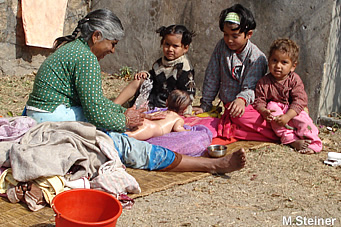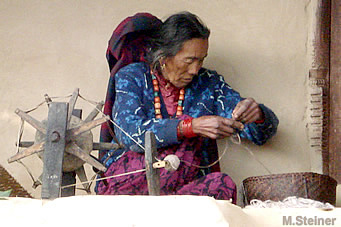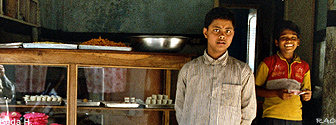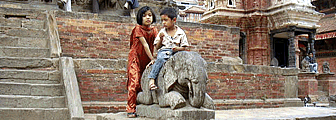|
| Impact
of Armed Conflict on Women and Children |
|
|
|
| Impact
of Armed Conflict on Women and Children |
UNIFEM
2006
|
 |
| Introduction |
 |
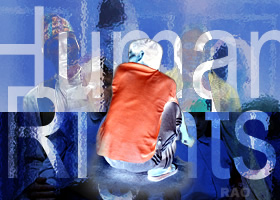 |
| In
February 1996, Maoist rebels started a 'People's War' in Nepal, demanding
social, economic, and political reform. Since that time, the Maoists sought
to achieve their demands through armed conflict, which was met by violent
government backlash. The resulting insurgency, led to an estimated 13,200
deaths and thousands of displaced individuals and families. Thousands of
people have been victims of trauma, forced displacement, and violence. |
|
The
plight of women and girls is more severe than that of their male counterparts
due to gender specific violence and inequalities exacerbated by the conflict.
Gender
specific violence led to immeasurable suffering of Nepali women and girls
during the insurgency. Rape, sexual abuse, and torture by both warring
sides were widespread. Sexual violence was used as a tool to punish women
for their alleged connection with either side of the conflict. Women, impregnated
with children conceived in rape, had little recourse to safe abortion services. |
Women were often forced to give birth in unsanitary settings because health
posts were regular targets of destruction. Women and girls have been trafficked
out of conflict-ridden areas only to find themselves victims of sexual
and domestic slavery in other parts of Nepal and India. The number of those
who have been infected with HIV and AIDS as a result of sexual exploitation
during the conflict is yet unknown.
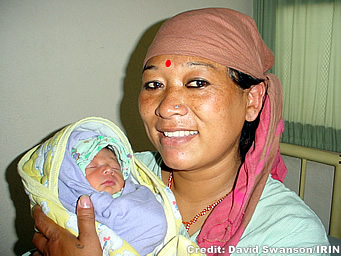 |
| The
insurgency also exacerbated gender inequalities, deeply rooted in traditional
religious and social practices. With increasingly insecure food supply,
women and girls' health was threatened by inequitable food distribution,
resulting in malnutrition and severe anemia. Girls' educational opportunities,
already less than those of boys, further diminished because of the need
for girls to enter the workforce in order to help support the family. Girls
with little education and no skills were often forced into exploitative
jobs. |
|
Mothers
faced particular hardship. As men and young people migrated out of the
country to avoid the conflict and seek opportunities abroad, married women
were left behind to care for children and the elderly, creating a heavy
burden of responsibility. Moreover as Nepali citizenship can only be passed
down through the father, mothers who gave birth to children of displaced,
missing or killed men were unable to confer citizenship on their children,
creating a generation of 'stateless children'. Though the House of Representatives
on May 30, 2006 has endorsed a landmark proposal to ensure a woman's right
to confer citizenship to her children, this it is yet to be reflected in
legislation.
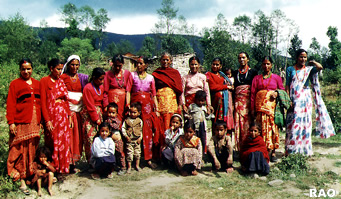 |
| Gender
inequalities exacerbated by the conflict also significantly burdened internally
displaced people including women. Due to discriminatory laws related to
property and welfare, women became particularly vulnerable when they were
driven away from their homes or when a husband or close male relative was
killed or injured. Even those entitled to compensation as a result of the
loss of a husband who was, for example, a police officer, were often unaware
of their legal entitlement. |
|
Increasing
number of widows found themselves without land or income. Women who were
compelled to leave their homes faced tremendous difficulty finding decent
employment because of lack of resources and skills. In order to survive
and support their families, displaced women were often forced to work in
exploitative conditions, subjecting them to abuse and trauma. Despite all
the suffering faced by Nepali women during the conflict they are glaringly
absent from national and international peace efforts.
A November 2004 scan
of consultants working on peace issues in Nepal revealed that all the two
hundred consultants were men. In the context of the changed political situation
in Nepal, on May 30, 2006 the House of Representatives unanimously endorsed
a landmark proposal reserving at least 33 percent of posts in the state
mechanism for women. But this has not been reflected in practice.
The government
did not include any women in all the Committees formed right after this
declaration. Women were even excluded from the Committee formed for drafting
the Interim Constitution compelling them to come to the streets. Without
addressing the gendered dimensions of the conflict and without women's
direct and active engagement in the peace process there is little hope
that a meaningful and sustainable peace can be achieved.
| Source:
UNIFEM, UNITED NATIONS Development Fund for Women, "A Rapid Scan-organisations
Working on Women and Peace in Nepal", 2006 |
 |
 |
 |
External
link |
 |
United
Nations Development Fund for Woman
UNIFEM
|
 |
UNIFEM |
| RAOnline |
 |
RAOnline |
|
 |
Source: UNICEF
|
Basic
Education
|
| UNICEF
report: Situation Analysis on the Children and Women in Nepal 2006 |
| 1.4
MB PDF-File |
|
| RAOnline |
 |
RAOnline |
Source: UNICEF
|
Backgroun
|
| UNICEF
report: Situation Analysis on the Children and Women in Nepal 2006 |
1.7
MB PDF-File |
|
 |
|
| more information |
 |
|





